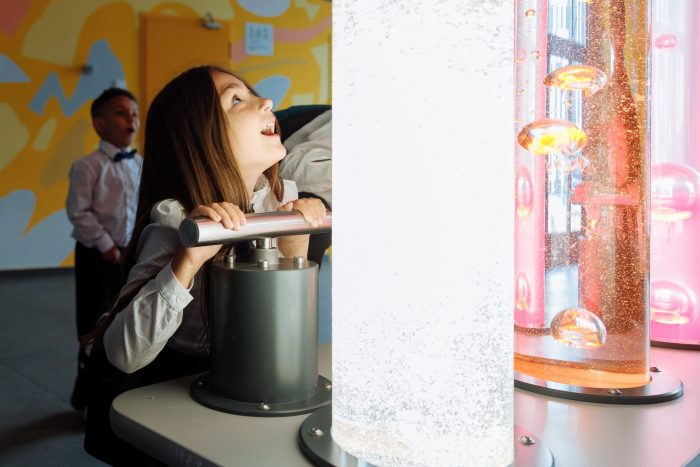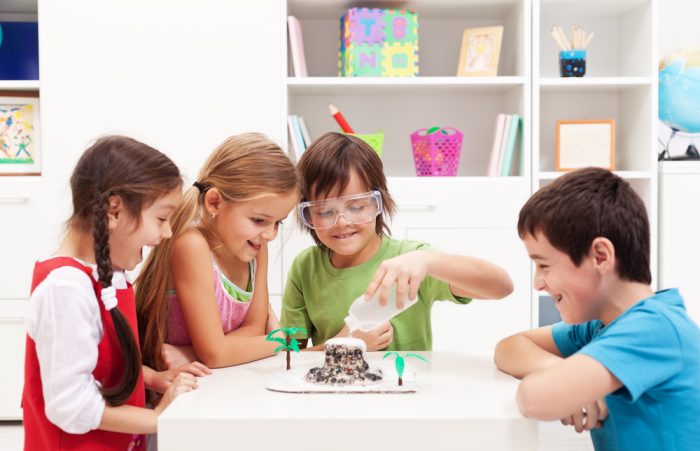We’ve all heard the classic boy versus girl stereotypes, right? Boys prefer to make mud pies while girls paint their nails. Boys like to blow things up while girls have a tea party. Boys cover themselves in paint while girls paint with dainty little strokes. Much of society has designed toys, books, and even homeschool curricula to match these stereotypes.
But when it comes to science, the volcano experiments and messy nature walks aren’t just for the boys! Inspiring the girls in your home to embrace science will not just encourage their love for STEM concepts. It will also help to bring the entire family together under one great love for the amazing scientific world. Boys and girls, unite!

Superwomen in Science

In 1903, Marie Curie became the first woman to ever win a Nobel Peace Prize (eight years later, she won it again!). Her pioneering research on radioactivity set the stage for countless discoveries in the world of atomic physics.
Long before Marie Curie’s time, Caroline Herschel followed in the footsteps of her brother and became an astronomer. She was the first woman to discover a comet, and she made many more discoveries in astronomy. She also won many awards and honors in a field typically dominated by men!
Kiara Nirghin may not be in history books (yet) for her scientific discoveries, but at just 16 years old, she won the 2016 Google Science Fair Award! Her orange and avocado peel water reservoir helped her South African homeland face a massive drought. Nirghin now travels around the globe as a speaker, proving that you’re never too young to make advancements in science.
These are just three women out of the countless women who have embraced their love for science and used it to make change in the world. We often hear names like Einstein, Newton, or Galileo, but we must remember that our girls are capable of loving and learning from science as well.
How You Can Inspire Girls to Embrace (And Love!) Science

It’s a known fact that your daughter or female student will have to participate in science – all kids do! But is it possible for them to love it? We’re here to say “absolutely!” and share a few ways you as the teacher or parent can help them along the way.
Include Female Science Role Models in Learning
As we mentioned above, there are SO many women of all ages throughout history who have made tremendous scientific advancements. Many traditional science books won’t highlight these women and their achievements, but that doesn’t mean you shouldn’t!
Here are a few books for your daughter or student that introduce female science role models in a positive way:
Little People, Big Dreams: Marie Curie
She Persisted in Science: Brilliant Women Who Made a Difference
The Girl Who Thought in Pictures
Gutsy Girls Go for Science: Astronauts (With STEM Projects!)
Talk Frequently About STEM Careers
“So, what do you want to be when you grow up?”
It’s a question we start asking our kids as toddlers, mostly because it’s fun to hear what their little brains come up with! But, in all seriousness, what will our kids be when they grow up? We should never push our kids toward a career that we want for them, but we can encourage them to explore numerous careers.
For example, if your science topic of the week is marine biology, explore what it means to be a marine biologist. Every scientific field has at least one career that goes along with it, and we can encourage girls to embrace science by talking about these careers on a regular basis. Pretend play is another great way to role-play STEM careers, especially with girls who tend to be more imaginative and creative.
Go to Science Museums

Science museums are one of the easiest ways to engage girls in STEM concepts, especially if you bring other kids! Most children’s museums are designed with hands-on pretend play in mind. This means your girls can play while they are immersed in STEM learning.
In addition to science museums, many libraries, art studios, community centers, and parks will host events centered around hands-on, fun learning.
Play Video Games and Board Games
Gasp. We’re recommending video games?! Well, within reason. Believe it or not, there are a lot of games available nowadays – both video and board – that encourage science from a competitive angle. Minecraft is a popular video game that promotes engineering concepts, along with problem-solving. PBS Kids offers simple, online science games for younger kids. Farming Simulator is designed for older learners, but it uses real-life agricultural concepts.
As for board games, the internet offers a wide range of options for all ages. You can shop a slew of options at Genius Games!

Incorporate Her Interests into Science
Does your student love to play pretend? Pretend to be a scientist! Transform the playhouse into a science lab or use art supplies to create an ecosystem where fish and frogs are friends. Or, if she loves to cook, take a break from traditional recipes and try out crystal candies or homemade ice cream in a bag.
Whatever her interests may be, think creatively as to how you can incorporate STEM concepts into these hobbies and activities.
A Science Curriculum for Boys and Girls Alike

At Journey Homeschool Academy, we have worked hard to create online science courses that both boys and girls will love. It’s a huge reason why one of our main instructors is a woman. We want your girls to see just how passionate women can be about science! Our hands-on activities encourage creativity, and our flexible coursework gives you as the teacher the opportunity to tailor learning to your daughter or student’s learning style.
Everyone can embrace science; you just have to get creative with it!
